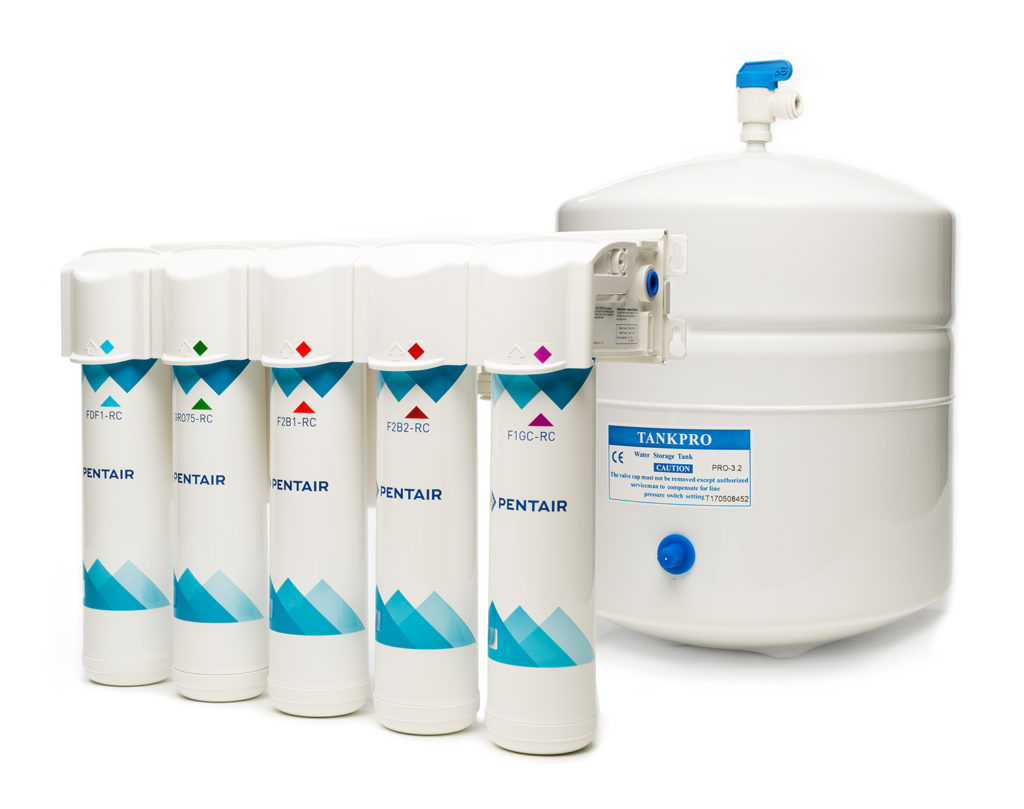About Reverse Osmosis
 How it works / What is does RO systems work by forcing water at house pressure thru a semi permeable membrane that, in conjunction with its carbon pre filters, rejects 95 to 99% plus of all contaminates and as well as hardness minerals. RO systems can reach high levels of purity as bacteria, microorganisms as well as arsenic, lead, fluoride and even pharmaceutical pollutants are removed. Carbon based filters such as countertop or box store filters cannot remove all of these impurities. RO water tastes delicious, makes superior coffee, tea, ice and is great to cook with.
How it works / What is does RO systems work by forcing water at house pressure thru a semi permeable membrane that, in conjunction with its carbon pre filters, rejects 95 to 99% plus of all contaminates and as well as hardness minerals. RO systems can reach high levels of purity as bacteria, microorganisms as well as arsenic, lead, fluoride and even pharmaceutical pollutants are removed. Carbon based filters such as countertop or box store filters cannot remove all of these impurities. RO water tastes delicious, makes superior coffee, tea, ice and is great to cook with.
Smaller residential Reverse Osmosis units In smaller residential RO units, water is produced slowly. It takes about 1 to 2 hours (depending on house water pressure, incoming water hardness and temperature) to fill the 2-1/2 or 5 gallon tank. Premium systems have a sediment filter, two carbon pre-filters, an RO membrane and a final carbon finishing filter, thus a 5 stage unit. The unit and the holding tank take up about 1/3 of the storage space of a 36″ sink cabinet. A small separate faucet is installed in the countertop, which can swing in for filling a pot or water jug on the countertop. Drilling thru granite or other material is required. This size unit, will produce enough pure water for drinking, cooking and ice making for a typical family. Although the faucet is small, when these units are correctly installed, the flow is robust and you can fill a glass in about 5 seconds and a medium size pot in 40 seconds or so.
RO Reject Water All RO units produce reject water which is directed into the sink drain. About 2-3 gallons is rejected for every 1 gallon produced but this amount can be minimized. (See below). The carbon filters remove chlorine, VOCS and the membrane rejects fluoride, lead, arsenic as well as hundreds of various chemicals, biological contaminates and hardness minerals. The rejected water basically returns to the hydrological cycle and is not really “wasted”. Drinking RO purified municipal water is less polluting by far than consuming plastic bottled water when all things are taken into account.
RO water is soft water similar to rainwater The process of producing RO water necessarily removes virtually all potentially beneficial minerals that may be present in the incoming water. It is estimated that we receive 99% plus of our minerals from food, so as long as a person eats reasonable quality food, there is no real concern that one might become mineral deficient from drinking RO water. It is worth noting that RO water is similar to rainwater. The Earth is continually demineralizing its waters and depositing it as surface water for all living things to drink and absorb. if birds can fly across oceans and squirrels can bolt up the side of a tree, it can’t possibly be unhealthy to drink demineralized water. Minerals, derived from plant and animal sources are abundant, broken down, considered organic, and are thus far more bio-available than than raw minerals in unprocessed water. There is more calcium in a glass of orange juice or a serving of kale than in 30 gallons of typical municipal water. A single multivitamin contains a more minerals than the water an average person consumes in a month. In essence, the importance of NOT consuming known dangerous pollutants and even nowadays, trace amounts of pharmaceutical drugs, outweighs by magnitudes, unfounded concerns of mineral deficiencies sometimes wrongly associated with consuming RO water.
A squeeze of lemon juice and a few grains of salt turns any purified water into an alkalizing and refreshing drink The RO process necessarily lowers the PH of the finished water to a more acidic condition. This issue, is for some persons, a concern as our bodies always strive to maintain a neutral PH of 7.35 to 7.45 through homeostasis. Our overall wellness in relation to the PH of various foods, beverages and water consumption is an extremely complex subject and can fill a book. Our stomach acid and lemon juice have a PH of around 2, so our own bodies adjust the PH levels of its various fluids to maintain optimal operations and life processes. If our stomach acids were too alkaline, we could not digest our food properly. Acidic citrus fruits actually end up creating alkaline conditions in our bodies so the processes are not as simple as one might think. A squeeze of lemon juice and a few grains of salt turns any purified water into an alkalizing and refreshing drink. The real culprits of an acidic body condition are what we eat, such as processed foods, refined carbohydrates, hydrogenated (damaged) fats, sweets, alcohol, processed meats, dairy and coffee. Dr Mercola recommends RO water as safe and healthy. Nature,s RO water is rainwater, distilled thru evaporation and millions of people and virtually every animal drink it every day with no ill effects.
Better than bottled water Using your new RO system is a great experience as you can now have better than bottled water for a fraction of the cost. Supporting the plastic bottled water industry, lugging cases of water and recycling bottles can be a thing of the past. Everything you make will taste better especially coffee, tea and soups. Drink from real glasses and buy glass travel bottles for your RO water. Avoid plastic containers as they can leach harmful chemicals into any liquid surrounding them.
To minimize waste water form your RO system, it is necessary to fill up a couple of water jugs in the morning. You can also fill up a covered pot kept next to the faucet and ladle it out for cooking. As it refills, back pressure from the tank, on the membrane builds and resists RO water production, gradually increasing the amount of reject water per ounce of RO water produced. The most water will be wasted by taking just one glass from a full tank. This doesn’t mean you can’t ever grab a glass form a full tank once in a while. Taking most or ALL the water from the tank minimizes the amount of reject water. It is also important to empty the tank once a month or so anyway. If you go away for 3 or 4 weeks, drain it to empty and let it refill again when you come home.
A well built and maintained RO unit can last indefinitely There are reports of 25 plus years of operation from users. Incoming water conditions and usage affect the maintenance requirements. For average water and family usage the sediment and carbon filters must be changed out every 10 to 12 months. With a whole house filter system, you can go up to 24 months. The RO membrane is extremely sensitive to chlorine and will fail if the unit is not maintained. During maintenance, we check the TDS (total dissolved solids) PPM (parts per million) reading on a meter to be sure it’s working properly. Incoming water with a 250 to 350 ppm reading will, with a well functioning RO membrane, show a PPM of 25 to 35 for purified water. Membranes should be changed every 3 to 5 years to minimize reject water.
A word on RO faucets In Massachusetts all RO installs must use an “air gap” faucet to meet the plumbing code. Because the reject water is directed to the drain, a back flow preventer is necessary and an air gap faucet is an accepted back flow preventer. An air gap faucet has 3 hoses connected to it. Besides the pure RO water in an isolated hose going to the faucet valve, the is a 1/4″ hose sending reject water into a small pool inside the base of the RO faucet on top of the counter. The pool never fills up as there is also a larger 3/8″ hose in the bottom of the pool draining to the sink tailpiece. A small hole is drilled in the back of the faucet base to allow air in or out of the drain / pool chamber. It the rare event of a house pressure loss and an even rarer suction of water BACKWARDS in the pipes, the air gap faucet will protect the RO unit from sucking waste water from the sink drain back into its filters and thus polluting the filter system. RO systems sold in box stores do not come with 3 hose ” air gap ” faucets and do not meet our local plumbing code. We also supply a code approved drain line adapter which allows the RO reject water to drain into the disposal unit.
RO units make some amount of noise It is normal for RO units to make the sound of flowing, trickling water while the unit is replenishing itself. Sounds can come from the air gap faucet as well as from the sink drain. It’s not very loud and you get used to it. It completely stops all of a sudden when the tank is full so you know you have plenty of great quality drinking water ready.
The ultimate system An RO in combination with a good Whole House Filter System such as our WH3500-IT is the ultimate system. The RO system is pampered and protected by its feed water already being highly purified allowing for extended filter life and really astounding quality drinking water.


